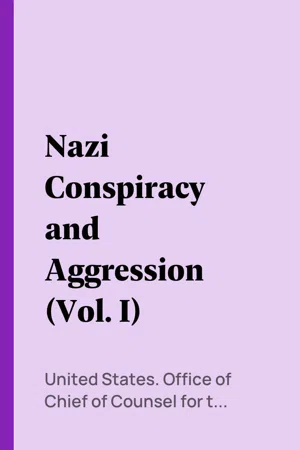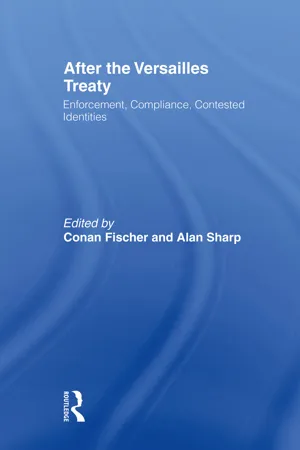History
Remilitarisation of the Rhineland
The remilitarization of the Rhineland refers to the 1936 decision by Nazi Germany to send military forces into the demilitarized zone along the Rhine River, in violation of the Treaty of Versailles and the Locarno Treaties. This move was a significant breach of international agreements and marked a key step in Adolf Hitler's expansionist ambitions, leading to increased tensions in Europe.
Written by Perlego with AI-assistance
Related key terms
3 Key excerpts on "Remilitarisation of the Rhineland"
- eBook - ePub
- United States. Office of Chief of Counsel for the Prosecution of Axis Criminality(Author)
- 2017(Publication Date)
- Perlego(Publisher)
It is far more essential to examine the advance measures included in Degree of Emergency A, to see whether one or other of the especially conspicuous measures could not be omitted.” (C-194) The reoccupation and fortification of the Rhineland was carried out on 7 March 1936. For the historical emphasis of this occasion, Hitler made a momentous speech on the same day, in which he declared: “Men of the German Reichstag! France has replied to the repeated friendly offers and peaceful assurances made by Germany by infringing the Reich pact through a military alliance with the Soviet Union exclusively directed against Germany. In this manner, however, the Locarno Rhine Pact has lost its inner meaning and ceased in practice to exist. Consequently, Germany regards herself, for her part, as no longer bound by this dissolved treaty. The German government are now constrained to face the new situation created by this alliance, a situation which is rendered more acute by the fact that the Franco-Soviet treaty has been supplemented by a Treaty of Alliance between Czechoslovakia and the Soviet Union exactly parallel in form. In accordance with the fundamental right of a nation to secure its frontiers and ensure its possibilities of defense, the German government have today restored the full and unrestricted sovereignty of Germany in the demilitarized zone of the Rhineland.” (2289-PS) The German reoccupation of the demilitarized zone of the Rhineland caused extensive international repercussions. As a result of the protests lodged with the League of Nations, the Council of the League made an investigation and announced the following finding, which is published in the League of Nations monthly summary, March, 1936, Volume 16, Page 78 - eBook - ePub
Land and Power
British and Allied Policy on Germany's Frontiers 1916-19
- Harold I. Nelson(Author)
- 2019(Publication Date)
- Routledge(Publisher)
3 He played up the danger that Germany might throw its lot in with Bolshevism, thus creating a mighty bloc of peoples and resources under the directing genius of German brains and organizing ability. His picture in this respect of Europe in revolution or on the verge of revolution did not appear exaggerated in March 1919. Bela Kun had just seized power in Hungary. The fear of a Bolshevik sweep into central and western Europe was current and alive in Paris.What terms for the western boundaries of Germany were drawn from these principles of peacemaking? His position here remained unchanged. The Rhineland provinces should not be separated from Germany. They should be demilitarized. No troops should be sent into the demilitarized area ‘for any purpose whatsoever without previous notification to the League of Nations’. The British Empire, a phraseology which covered the Dominons as well as the United Kingdom, and the United States should undertake to aid France if Germany militarily invaded the Rhineland ‘without the consent of the Council of the League of Nations. This guarantee to last until the League of Nations had proved itself to be an adequate security.’1These terms did not permit the French to enter the demilitarized zone without the consent of the League of Nations, i.e. no occupation. The guarantee was not necessarily to be permanent. Furthermore, demilitarization might be temporary because by inference the situation might arise when Germany would have the consent of the League Council to move troops across the Rhine.On March 27, the Council of Four debated Lloyd George’s memorandum.2 Clemenceau made a moving appeal to Lloyd George and Wilson to understand the French need for and right to security. On the oceans, the destruction of German naval power gave security to England and America. ‘Il nous en faut une équivalente sur terre.’3 - eBook - ePub
After the Versailles Treaty
Enforcement, Compliance, Contested Identities
- Conan Fischer, Alan Sharp(Authors)
- 2013(Publication Date)
- Routledge(Publisher)
Three issues are paramount here. The first relates to the difficulties encountered in practice when attempting to implement the Treaty provisions. Secondly, the practicalities of Britain’s position as an occupying power drew her further into the minefield of European politics than policy-makers would have wished, often making her vulnerable to pressure from both France and Germany as tensions between the two increased. Finally, the practicalities of policy implementation on the ground highlighted (and indeed, on occasion, exacerbated) weaknesses and inconsistencies in Britain’s overall European policy at the political level. This resulted in a dynamic, symbolic policy-making relationship between the periphery and London. Through considering the specifics and detailed implementation of the Treaty of Versailles in this way, it is hoped to shed fresh light on the viability and wider record of the overall peace settlement.The Formulation of the Rhineland Agreement: Negotiations at Paris, 1919Even before the allied leaders convened in Paris in January 1919, the question of the Rhineland had proved contentious. At the armistice negotiations in the autumn of 1918 the lines of difference between the Allies were already revealed, for the French were eager to ensure their long-term security by changes to their eastern boundaries. Perhaps anticipating a cool reception from the British, Marshal Foch targeted the Americans. He had some success. Colonel House (Wilson’s special envoy at the armistice negotiations) made crucial concessions, amounting in practice to the acceptance of some kind of allied occupation of the Rhineland. Britain, represented by Lloyd George, then had little option but to agree also.Thus, the armistice agreement, signed on November 11, 1918, contained specific terms regarding the Rhineland: Germany must withdraw 40 kilometres beyond the right bank of the Rhine, allowing the Allies to occupy the left bank plus three bridgeheads, 30 kilometers deep on the right bank. The remaining evacuated territory would form a neutral zone.1
Index pages curate the most relevant extracts from our library of academic textbooks. They’ve been created using an in-house natural language model (NLM), each adding context and meaning to key research topics.


